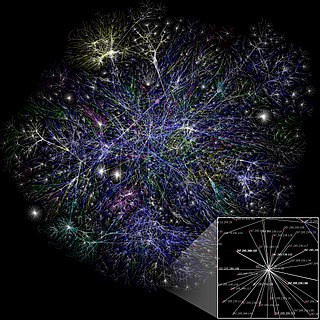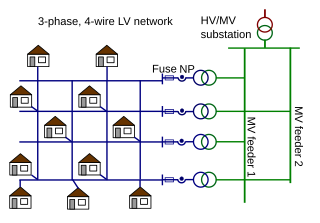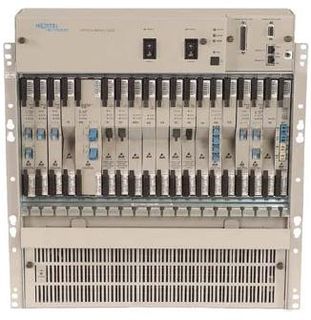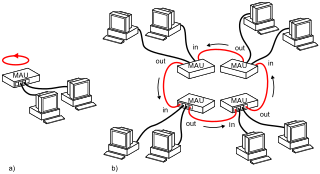 W
WNetwork topology is the arrangement of the elements of a communication network. Network topology can be used to define or describe the arrangement of various types of telecommunication networks, including command and control radio networks, industrial fieldbusses and computer networks.
 W
WThe arbitrated loop, also known as FC-AL, is a Fibre Channel topology in which devices are connected in a one-way loop fashion in a ring topology. Historically it was a lower-cost alternative to a fabric topology. It allowed connection of many servers and computer storage devices without using then very costly Fibre Channel switches. The cost of the switches dropped considerably, so by 2007, FC-AL had become rare in server-to-storage communication. It is however still common within storage systems.It is a serial architecture that can be used as the transport layer in a SCSI network, with up to 127 devices. The loop may connect into a fibre channel fabric via one of its ports. The bandwidth on the loop is shared among all ports. Only two ports may communicate at a time on the loop. One port wins arbitration and may open one other port in either half or full duplex mode. A loop with two ports is valid and has the same physical topology as point-to-point, but still acts as a loop protocol-wise. Fibre Channel ports capable of arbitrated loop communication are NL_port and FL_port, collectively referred to as the L_ports. The ports may attach to each other via a hub, with cables running from the hub to the ports. The physical connectors on the hub are not ports in terms of the protocol. A hub does not contain ports. An arbitrated loop with no fabric port is a private loop. An arbitrated loop connected to a fabric is a public loop. An NL_Port must provide fabric logon (FLOGI) and name registration facilities to initiate communication with other node through the fabric.
 W
WBroadcast, unknown-unicast and multicast traffic is network traffic transmitted using one of three methods of sending data link layer network traffic to a destination of which the sender does not know the network address. This is achieved by sending the network traffic to multiple destinations on an Ethernet network. As a concept related to computer networking, it includes three types of Ethernet modes: broadcast, unicast and multicast Ethernet. BUM traffic refers to that kind of network traffic that will be forwarded to multiple destinations or that cannot be addressed to the intended destination only.
 W
WIn computer networking, telecommunication and information theory, broadcasting is a method of transferring a message to all recipients simultaneously. Broadcasting can be performed as a high-level operation in a program, for example, broadcasting in Message Passing Interface, or it may be a low-level networking operation, for example broadcasting on Ethernet.
 W
WA bus network is a network topology in which nodes are directly connected to a common half-duplex link called a bus.
 W
WA butterfly network is a technique to link multiple computers into a high-speed network. This form of multistage interconnection network topology can be used to connect different nodes in a multiprocessor system. The interconnect network for a shared memory multiprocessor system must have low latency and high bandwidth unlike other network systems, like local area networks (LANs) or internet for three reasons:Messages are relatively short as most messages are coherence protocol requests and responses without data.Messages are generated frequently because each read-miss or write-miss generates messages to every node in the system to ensure coherence. Read/write misses occur when the requested data is not in the processor's cache and must be fetched either from memory or from another processor's cache.Messages are generated frequently, therefore rendering it difficult for the processors to hide the communication delay.
 W
WThe Cambridge Ring was an experimental local area network architecture developed at the Computer Laboratory, University of Cambridge starting in 1974 and continuing into the 1980s. It was a ring network with a theoretical limit of 255 nodes, around which cycled a fixed number of packets. Free packets would be "loaded" with data by a machine wishing to send, marked as received by the destination machine, and "unloaded" on return to the sender; thus in principle, there could be as many simultaneous senders as packets. The network ran over twin twisted-pair cabling.
 W
WIn graph theory, the cube-connected cycles is an undirected cubic graph, formed by replacing each vertex of a hypercube graph by a cycle. It was introduced by Preparata & Vuillemin (1981) for use as a network topology in parallel computing.
 W
WThe fat tree network is a universal network for provably efficient communication. It was invented by Charles E. Leiserson of the Massachusetts Institute of Technology in 1985.
 W
WA feeder line is a peripheral route or branch in a network, which connects smaller or more remote nodes with a route or branch carrying heavier traffic. The term is applicable to any system based on a hierarchical network.
 W
WAnja Feldmann is a German computer scientist.
 W
WA grid network is a computer network consisting of a number of computer systems connected in a grid topology.
 W
WIn computer networking, hypercube networks are a type of network topology used to connect multiple processors with memory modules and accurately route data. Hypercube networks consist of 2m nodes, which form the vertices of squares to create an internetwork connection. A hypercube is basically a multidimensional mesh network with two nodes in each dimension. Due to similarity, such topologies are usually grouped into a k-ary d-dimensional mesh topology family, where d represents the number of dimensions and k represents the number of nodes in each dimension.
 W
WA mesh network is a local network topology in which the infrastructure nodes connect directly, dynamically and non-hierarchically to as many other nodes as possible and cooperate with one another to efficiently route data from/to clients. This lack of dependency on one node allows for every node to participate in the relay of information. Mesh networks dynamically self-organize and self-configure, which can reduce installation overhead. The ability to self-configure enables dynamic distribution of workloads, particularly in the event a few nodes should fail. This in turn contributes to fault-tolerance and reduced maintenance costs.
 W
WA metropolitan-area Ethernet, Ethernet MAN, or metro Ethernet network is a metropolitan area network (MAN) that is based on Ethernet standards. It is commonly used to connect subscribers to a larger service network or the Internet. Businesses can also use metropolitan-area Ethernet to connect their own offices to each other.
 W
WMulti-link trunking (MLT) is a link aggregation technology developed at Nortel in 1999. It allows grouping several physical Ethernet links into one logical Ethernet link to provide fault-tolerance and high-speed links between routers, switches, and servers.
 W
WRadia Joy Perlman is an American computer programmer and network engineer. She is most famous for her invention of the spanning-tree protocol (STP), which is fundamental to the operation of network bridges, while working for Digital Equipment Corporation. She also made large contributions to many other areas of network design and standardization, such as link-state routing protocols.
 W
WIn telecommunications, point-to-multipoint communication is communication which is accomplished via a distinct type of one-to-many connection, providing multiple paths from a single location to multiple locations.
 W
WA ring network is a network topology in which each node connects to exactly two other nodes, forming a single continuous pathway for signals through each node – a ring. Data travels from node to node, with each node along the way handling every packet.
 W
WIn graph theory, the shuffle-exchange network is an undirected cubic multigraph, whose vertices represent binary sequences of a given length and whose edges represent two operations on these sequence, circular shifts and flipping the lowest-order bit.
 W
WA star network is an implementation of a spoke–hub distribution paradigm in computer networks. In a star network, every host is connected to a central hub. In its simplest form, one central hub acts as a conduit to transmit messages. The star network is one of the most common computer network topologies.
 W
WIn mathematics, Szymanski's conjecture, named after Ted H. Szymanski (1989), states that every permutation on the n-dimensional doubly directed hypercube graph can be routed with edge-disjoint paths. That is, if the permutation σ matches each vertex v to another vertex σ(v), then for each v there exists a path in the hypercube graph from v to σ(v) such that no two paths for two different vertices u and v use the same edge in the same direction.
 W
WToken Ring is a computer networking technology used to build local area networks. It was introduced by IBM in 1984, and standardized in 1989 as IEEE 802.5.
 W
WA tree network, or star-bus network, is a hybrid network topology in which star networks are interconnected via bus networks. Tree networks are hierarchical, and each node can have an arbitrary number of child nodes.
 W
WA tree network, or star-bus network, is a hybrid network topology in which star networks are interconnected via bus networks. Tree networks are hierarchical, and each node can have an arbitrary number of child nodes.
 W
WA tree network, or star-bus network, is a hybrid network topology in which star networks are interconnected via bus networks. Tree networks are hierarchical, and each node can have an arbitrary number of child nodes.